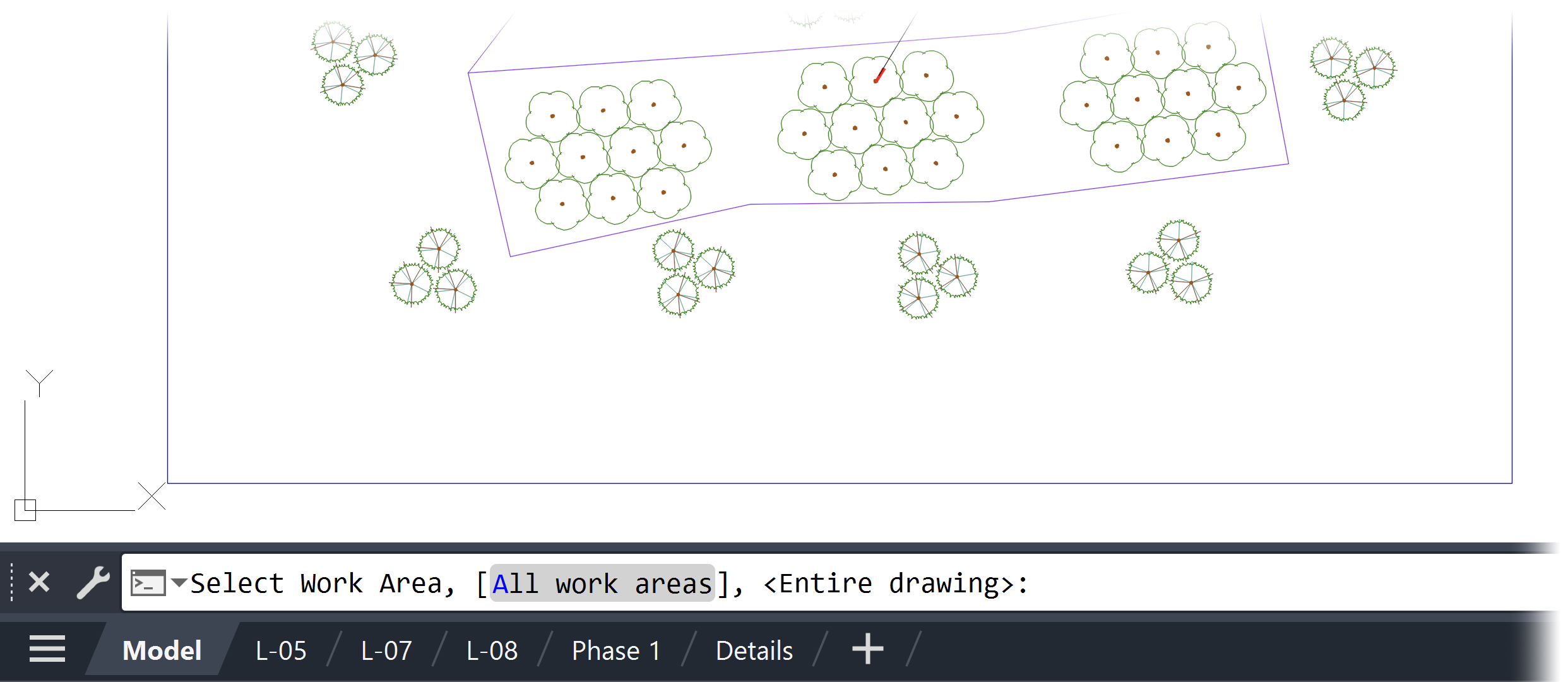Nested Work Areas
Quick video
Land F/X now supports nested Work Areas, meaning that:
- Work Areas can be drawn within themselves, and
- Tools like the Plant Schedule will only recognize "smart" Land F/X objects such as plants, irrigation equipment, Reference Notes such as site amenities and hardscape objects, etc., within the boundary of a selected Work Area boundary.
Nested Work Areas can be especially helpful when you need to limit your schedules to a single Work Area in your plan.
Nested Work Areas Overview
Our support for nested Work Areas means you can now run a schedule (such as a Planting, Irrigation, or Reference Notes Schedule) that will only recognize Land F/X objects within a Work Area boundary, but not within any other Work Areas you've created within that Work Area (aka nested Work Areas). This capability makes it much easier to include specific Land F/X objects in your schedules – or exclude those objects from your schedules.
Note that our support of nested Work Areas will also further necessitate the use of Work Areas in your external references (Xrefs) to take advantage of their full power.
For further information on Work Areas, see our documentation on:
- Work Areas
- Limiting the following schedules using Work Areas:
How Nested Work Areas Function
Let's start with a simple example that illustrates how nested Work Areas function.
In this example image, we have an exterior Work Area named Perimeter Planting that contains a nested Work Area named Interior Planting.

With our Work Areas drawn in this way, the Plant Schedule will recognize the plants placed within the Perimeter Planting Work Area but not in the Interior Planting Work Area, and the opposite.

Let's confirm: Our group plant labels show we have 24 counts of one tree species in the Perimeter PlantingPerimeter Work Area and 30 counts of another tree in the Interior Planting Work Area.
After running Plant Schedules based on both Work Areas, we can see that the Perimeter Planting Work Area only recognizes the plants placed within it, and not also within the Interior Planting Work Area.

Nested Work Areas as Xrefs
Let's say we also wanted to generate a Plant Schedule that recognizes and counts all placed plants. In this case, we'd need to be able to "turn off" certain Work Areas to exclude them from the schedule. The easiest way to accomplish this task would involve using the Work Areas as Xrefs, allowing us to load and unload Work Areas as we need them.
See our Work Areas in Xrefs documentation to learn about different ways to place Work Areas in a drawing that will be used as an Xref in your design drawings. At its simplest, each level of nested Work Areas should be its own Xref.
When running a Plant Schedule, we can type A to include the plants in All work areas, or right-click to include plants from the <Entire drawing>.

The example Plant Schedules pictured below show a schedule based on All work areas and another schedule based on the Entire drawing compare with the Work Area–specific schedules pictured above.

Note that if other Work Areas are present in the drawing, or other plants have been placed in the drawing, those options won't work to create a Plant Schedule that combines the interior and perimeter plants into one schedule. In this case, we'd need to make a third Work Area, and turn at least the perimeter and interior Work Areas into Xrefs, or all three Work Areas into separate Xrefs. Remember that each level of nested Work Area should be its own Xref.
In this example, we've drawn a third Work Area around our Perimeter Planting and Interior Planting Work Areas. We've turned each of these Work Areas into its own separate Xref, taking care to name each of these files to represent their nesting order and using the word Level to denote them. As a result, we'll be able to place any Work Areas that are drafted at the same level of nesting into the same file, to then be controlled together.

If we need to run a Plant Schedule that recognizes only the Perimeter Planting and Interior Planting plants, but ignores any other potentially placed plants and Work Areas, we can unload those Xrefs. We can see that our newest Work Area recognized all plants within its boundaries, and the Plant Schedule reflects this fact with no acknowledgement of the unloaded Work Areas.

In our example, we chose to not place the BLDG 5 Courtyard Work Area into an Xref because that Work Area can be controlled via the current drawing's Layer Properties. If we wanted to, we could also place that Work Area into a Level 1 Work Area Xref.







